 Here are some often-asked questions that may help you understand the thermoforming process, and Waveform Plastics. Should you have any questions, feel free to contact us at any time, at info@waveformplastics.com.
Here are some often-asked questions that may help you understand the thermoforming process, and Waveform Plastics. Should you have any questions, feel free to contact us at any time, at info@waveformplastics.com.
1. What is thermoforming and vacuum forming?
2. What are the benefits of thermoforming?
3. What parts are a good "fit" for thermoforming?
4. What do you need from me to make a part?
5. Is tooling (the mold, in this case) expensive?
6. What do you make molds from?
7. What's the difference between a positive and a negative mold?
8. What is a typical minimum run (part quantity)?
9. What's the typical lead time?
10. Should I thermoform or injection mold my part?
11. When thermoforming a part, why can only one side be controlled?
12. What types of plastic can you form?
13. What material thickness can you form?
14. What type of product or shape "fits" the thermoforming process?
15. What standard products does Waveform Plastics offer?
16. Where can you ship to?
17. How do I get a quote on a part?
18. What are the best methods of transport from Waveform Plastics?
19. Where can I find answers to my other plastics and thermoforming related questions?
20. Glossary of Terms
1. What is thermoforming and vacuum forming?
Thermoforming is the process of heating a sheet of plastic material, and using pressure to shape it using a mold. Vacuum forming refers to the use of vacuum to force the plastic into the shape of the mold. We also do pressure forming, which, as you might guess, uses pressure, along with vacuum, to force the plastic into the mold cavity. Drape forming, the simplest form of thermoforming, primarily uses gravity to form the part over a mold. Each type of forming has it's own specific advantages. To learn more about the thermoforming process, see this guide (Adobe Acrobat pdf format). 
2. What are the benefits of thermoforming?
Thermoforming is efficient and very cost-effective for the production of many plastic parts depending on the part size, shape, and quantity. Up-front costs are usually much lower, and lead times to tooling and production are generally much shorter than other processes such as injection molding. Temporary tooling offers an inexpensive short-term test for design issues and product market acceptance. 
3. What parts are a good "fit" for thermoforming?
Large panels, housings, enclosures, and other similar parts are ideal for thermoforming. Tooling costs for these parts is considerably less than for injection molding, which due to the large part size may have prohibitive tooling costs. Parts with features mostly confined to one side of the part are best suited to thermoforming, but it is often possible to implement or add features to the uncontrolled side during forming, trimming, fabrication, and assembly. 
4. What do you need from me to make a part?
We've started from a drawing on a napkin! If you have a concept, then we can create a design, including CAD models, renderings, and detailed drawings. If, on the other hand, you already have a CAD model or design, we can start from that and create molds and other tooling that will allow us to make the finished product. Our services include everything from design to prototypes to production, and we can do as much or as little as you need us to do. 
5. Is tooling (usually the mold and trim fixtures, in this case) expensive?
The molds used in thermoforming are designed based on a variety of factors - life expectancy, finish, complexity, and tolerances, to name a few. Generally speaking, tooling for thermoforming is much cheaper than that for other processes, such as injection molding. Molds can be as cheap as a few hundred dollars, depending on the specific requirement. Don't be scared away by up-front costs. Thermoforming can be extremely economical, especially for low to medium volume applications. 
6. What do you make molds from?
Production molds are typically cast or machined from aluminum. Deeper molds are usually cast, while shallower molds may be machined directly from a block of aluminum. Aluminum molds can be temperature controlled, which allows tight tolerances, better detail, and shorter cycle times (which translates into a lower cost part). Molds may also be made from various composites which offer short or medium life and easy machining. For prototypes or lower quantity production runs, we'll often make a mold from varying densities of polyurethane board (such as Renboard or Prolab). For prototypes, we can also use medium density fibreboard (MDF), a wood product. We will recommend the best tooling option based on your design requirements and volumes. 
7. What's the difference between a male and female mold?
The decision to use a male (or positive) mold or a female (or negative) mold depends on the shape of the part, where tolerances are important, surface finish, mechanical requirements of the finished part, and many other factors. With a male mold, the plastic is stretched over the mold, and then vacuum is applied to draw the plastic down onto the surface of the mold.
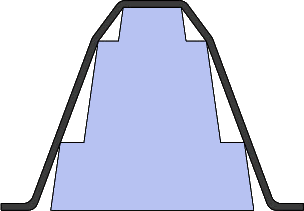
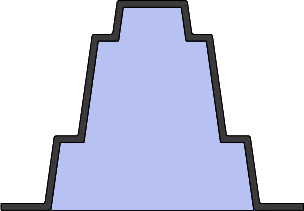
With a female mold, the plastic is drawn down into a cavity by the vacuum.
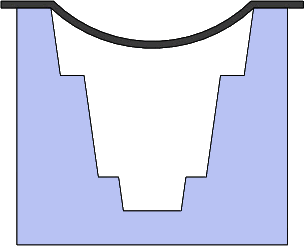
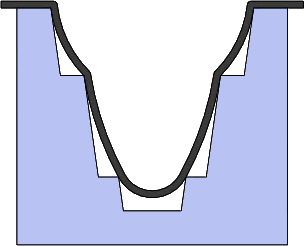
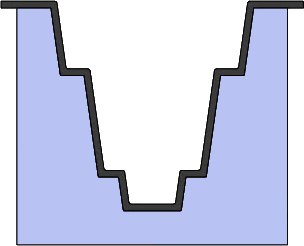

8. What is a typical minimum run (part quantity)?
There are two minimums: production and material. Production minimums vary greatly, based on setup times and part complexity. We'll do just a few parts if needed, especially for prototyping. There is really no production "minimum". Materials also affect minimum quantities. If we can use a stock material, then there is typically no minimum quantity. However, if you require a specific colour, or have special material requirements, minimum quantities are often based on a minimum extrusion run for the plastic, typically 2500 to 5000 pounds. 
9. What's the typical lead time?
Simple prototypes are often prepared in two to three weeks. Again, this can vary, but we do try to minimize prototype turnaround to keep your design cycle short. Production lead times can vary based on material requirements and availability, and quantity. From approval of a prototype, typical production lead time is from as little as one week to a month or two for more complex parts, or in cases where production tooling needs to be fabricated. 
10. Should I thermoform or injection mold my part?
Both process are unique, and offer specific advantages and disadvantages. Thermoforming typically has a lower up-front cost, while injection molding is ideal when you're producing hundreds of thousands of parts. Look here for a more detailed comparison. 
11. When thermoforming a part, why can only one side be controlled?
The mold defines the shape of the plastic, and tolerances can be controlled on the side of the plastic that contacts the mold. The opposite side, away from the mold, is predictable, but not controlled, because the plastic will stretch around the mold and produce varying thicknesses. There are a number of techniques that we use to minimize this effect, when it's important. 
12. What types of plastic can you form?
There are many plastics that can be thermoformed. Many are designed specifically for thermoforming. You can choose from a wide range of engineering plastics to precisely meet your job requirement. Just few of these materials that we work with include:
- ABS
- High impact polystyrene (HIPS)
- PET (PETG, APET, RPET, etc.)
- TPO
- Acrylic
- Polyethylene (HDPE, HMWPE, LDPE)
- Polypropylene
- Polycarbonate
- Specialty materials such as Kydex and Royalex

13. What material thickness can you form?
We typically use materials in the 0.040" to 0.375" range, although we have occasionally worked with materials as thin as 0.020" and as thick as 0.500". While we don't typically form materials thicker than 0.500", we can machine parts from thicker plastics on our in-house 3- and 5-axis CNC routers. 
14. What type of product or shape "fits" the thermoforming process?
We are always happy to evaluate anything, so feel free to send us your drawing or picture. There are often ways to make even complex parts using the thermoforming process, whether it involves making the part from more than one component, or performing post-machining or assembly. The following guidelines do not define the limitations of thermoforming - they are tips to help you design the most thermoformable part. It is often possible to incorporate features into a part that help the thermoforming process, without impacting the functionality of the part.
So, as a general guideline, here are some tips to help you design a more thermoformable part:
- The part should be able to be formed over a mold screwed to a flat table, and then pulled off of the mold after the plastic has cooled. We can also form plastic down into a hollow cavity. Which we choose depends on the shape of your part, and your design requirements and goals. See FAQ question 7, above, for the shapes of the mold.
- Undercuts (having the part wrap under the mold at any point) can complicate the process. Tooling can allow for this with slides and inserts, so it certainly isn't impossible, but that complexity will often make tooling more costly.
- We like to see some draft (angle) on the outside walls of the part. Think of a man's top hat, where the side walls of the hat are vertical, forming a cylinder. If we form that over a cylindrical mold (which we can do), then the plastic cools and shrinks, it will grip the mold so hard that we may not be able to pull the part off of the mold. If the cylinder were more of a cone shape, then the problem is solved. Vertical walls may not be a problem if the vertical wall height is much less than the overall size of the part. This very much depends on the shape of the part, and there are always exceptions to this rule!
- It can be difficult, but not at all impossible, to form a very tall, narrow part. If we take the man's top hat again, and make it more cone shaped, it can still pose a problem because of the height. Plastic will stretch over the top and down the sides, and two things can happen: (1) the plastic becomes very thin and weak because as it stretches it also thins out, and (2) the plastic webs - all the excess plastic that needs to go somewhere as it pulls into the mold forms folds. This is usually a bigger problem with square boxes, where the webbing occurs in the four corners. There are ways to improve the situation, so we always want to evaluate your design before assuming that thinning or webbing is a problem, even for deep draws (tall parts).
- Tooling (molds) to form clear parts can be more costly due to the additional processing or special materials needed to prepare the mold. It isn't a problem to do, but tooling will likely be more costly.
- When the quantity of parts to be made is high, then complex tooling can be justified because the cost is amortized over hundreds or thousands of parts. If you are only looking for a few or a few dozen parts, complex tooling can increase part cost significantly, so it becomes more important to design the part for the simplest possible tooling.
There are always exceptions, so we encourage you to contact us with your drawing or picture. 
15. What standard products does Waveform Plastics offer?
Everything that Waveform Plastics manufactures is custom to each of our customers. We do not sell any "standard" products. None of the pictured products on our website are available for purchase directly from Waveform. 
16. Where can you ship to?
We have customers throughout North America. If you require overseas shipment, let us know, and we can probably arrange that, too. 
17. How do I get a quote on a part?
Complete our online quote request form, or contact our sales staff for assistance. For us to quote a project, we really need to see a sketch or CAD model, plus we need to know quantities to quote, material type and gauge (or let us know what your design goals are and we can probably offer some suggestions), and the number of parts you expect to make over the life of the project - that helps us determine the type of tooling (molds) you will need. 
18. What are the best methods of transport from Waveform Plastics?
All couriers typically deliver next-day within Ontario. However, for urgent small packages, we strongly recommend using Purolator due to their pickup scheduling. Purolator picks up and drops off daily between 2:00 and 4:00PM. Purolator pickups must be booked no later than 1:00PM same-day. Other couriers, such as FedEx, UPS, or CanPar also pick up daily, but typically require the pickup request to be submitted the day before shipping. We recommend that you contact the courier company to confirm pickup and delivery times for urgent packages. We work with a number of companies that offer excellent and prompt LTL service for larger loads. Please contact us for more information. 
19. Where can I find answers to my other plastics and thermoforming related questions?
Contact our staff for answers to any questions you may have! 
20. Glossary of Terms
- Chill mark or chill line: A mark or line on the formed part that is typically a result of the plastic coming in contact with a cold mold or plug.
- Cut-sheet: Usually heavy-gauge sheet, manually or automatically fed one at a time into a thermoformer.
- Density: Weight per unit volume.
- Dimensional tolerance: Part-to-part variation in a dimension.
- Draft: The angle on a surface relative to vertical. Draft is often required to allow a part to release more easily from a mold.
- Drape forming: The process of laying or stretching a heated sheet of plastic over a mold, usually without the use of vacuum or pressure.
- Draw ratio: A measure of the area of the sheet after being formed to that before forming. Imagine if we start with a 12" x 12" sheet of plastic, and draw it into a shallow dome shape. This would be a relatively low draw ratio. The surface area of the dome is not significantly higher than the surface area of the flat sheet we started with. Now, instead, draw that 12" x 12" into the shape of a 12" deep pail. The flat sheet has to pull down into that cavity and cover the vertical walls, as well as the bottom surface of the pail. This would be a very high draw ratio. A high draw ratio can result in excessively thin areas in a part. We have techniques that can help to improve this in many cases.
- Extrusion: The process of producing plastic sheet where the resin is heated and squeezed between two rollers to produce a continuous ribbon of plastic, which when cooled is either cut into sheets or rolled.
- Free surface: The sheet surface that is not in contact with the mold surface.
- Female mold or negative mold: A mold which consists primarily of a cavity, into which the heated sheet is stretched.
- Heavy-gauge or thick gauge: Plastics thicker than 3mm (0.118") are typically referred to has heavy gauge.
- MDF: Medium density fiberboard, often used to make prototype molds and other fixtures.
- Male mold or positive mold: A mold which consists primarily of a raised surface, over which the heated sheet is stretched.
- Mark-off: A mark on the formed part that is a result of contact with plug.
- Plastic: A mixture of polymers and various additives which, for thermoforming, become soft and can be formed when heated. Not all plastics can be thermoformed, though.
- Plug or Plug Assist: A mechanical device used to aid or assist sheet stretching. This can help improve material distribution, and can help add features not possible otherwise.
- Pressure forming: The use of pressure and vacuum to increase the contact between the plastic sheet and the mold, which can improve the detail in a part. Pressure forming can, for example, allow texture on a mold to print off onto the part.
- Roll-fed: Thin-gauge sheet, fed continuously from a roll into the thermoformer.
- Router: A tool for trimming heavy-gauge parts. Waveform uses hand routers and computer-controlled routers to trim parts.
- Sag: The distortion or "droop" of a sheet caused by its own weight when heated.
- Shrinkage: The change in dimension of plastics as it cools. The greatest concern for a thermoformer is the shrinkage of the plastic part as it cools after being formed on a mold. This means that the part will be a different size than the mold. To deal with this, we typically scale the mold up by a small amount - typically 0.5% to 1%.
- Shuttle thermoformer: Heavy-gauge thermoforming machine in which the sheet moves horizontally into the oven, and out to the forming area.
- Steel rule die: Sharpened steel blade that is shaped to the perimeter of a part. The part is placed into a press, and the blade is pushed into the part to cut out the shape. This can typically be used only on thin gauge materials.
- Thermoforming: The general term for vacuum forming, pressure forming, and drape forming.
- Thin-gauge: Plastics thinner than 1.5mm (0.060") are typically referred to as thin gauge.
- Trim or flash: The portion of the formed sheet that is cut away from the finished part.
- Vacuum forming or vacuforming: The use of vacuum to draw a heated sheet of plastic over a mold to form a part.
- Virgin plastic: Virgin plastics are comprised of polymers which have not been reprocessed. Plastics can contain some amount of recycled material, in which case they are not virgin.
- Web: When forming a part, a web occurs where there is an excess of plastic which cannot be drawn down onto the mold.
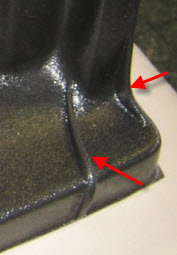
Examples of Webbing
